
table of contents
- Shade perennials from B to G
- Shade perennials from H to S
- Shade perennials from T to W
- frequently asked Questions
Shady locations can be a challenge when it comes to greening. However, there are some plants that are also suitable for such places. Here we present 24 perennials, which also thrive in the shade of the north side without any problems.
In a nutshell
- For the north side there are not only upright solitary perennials, but also plants that spread out flat
- Plants for the shade like a moist soil, but waterlogging must not develop
- Shade plants such as hostas or elven mirrors have attractive foliage
- Many shade plants do not require any care and can largely be left to their own devices
- There are perennials for the shade at different heights, which also makes it easy to create shade beds
Shade perennials from B to G
Mountain forest cranesbill (Geranium nodosum)

- Height: 40 to 50 cm
- Habit: bushy, forms rhizomes, upright flower stalks
- Flower: light purple, simple
- Flowering period: May to September
- Leaves: multi-part, serrated leaf margin
- Soil: fresh, well-drained, very humic, prefers acidic soils
- Use: edge of wood, underplanting of wood
Monkshood (aconite)

- Height: 80 to 100 cm
- Growth: upright, forms loose clumps
- Flower: depending on the variety, yellow, white or blue
- Flowering period: July to August
- Leaves: deeply incised, dark green, deciduous
- Soil: fresh, well-drained, nutrient-rich, humus, loamy, sandy, also tolerates a slightly acidic pH value
- Use: bedding, outdoors, underplanting with woody plants
Elven flower (Epimedium)

- Height: 20 to 35 cm
- Growth: pillow-like, forms rhizomes
- Blossom: sulfur yellow, racemose
- Flowering period: April to May
- Leaves: heart-shaped, toothed edge, leathery, brown-green, evergreen
- Soil: fresh, moist, humic, well-drained
- Use: underplanting with trees, Ground cover
Note: There are different types of elven flowers, which differ in the color of the foliage and the flowers.
Maidenhair fern (Adiantum)

- Height: 40 to 50 cm
- Growth: arching, expansive
- Flower: none
- Leaves: fan-like, pinnate-like, leaf margin with notches, light green
- Soil: well-drained, fresh, moist, lots of humus
- Use: Underplanting with trees, specimen plants
Hosta
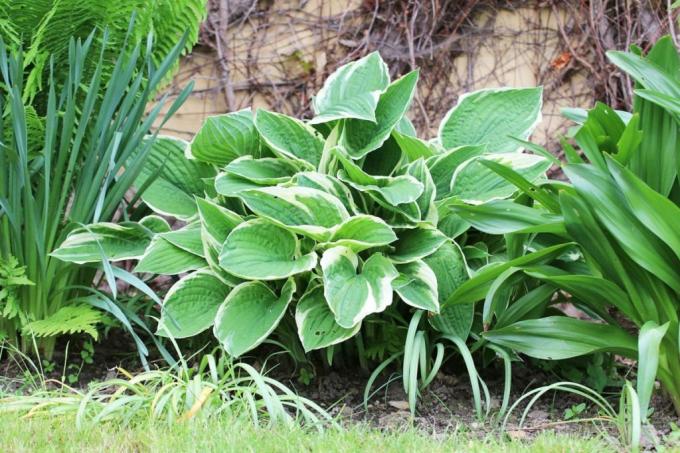
- Height: 30 to 50 cm
- Growth: upright, clumpy, bushy
- Flower: light purple
- Flowering period: June to July
- Leaves: deciduous, large, heart-shaped
- Soil: fresh, well-drained, rich in nutrients, humic
- Use: Underplanting with trees, specimen plants, tubs, beds with shade
Few perennials are so well adapted to a place that is shady. The advantage of the Hosta is that it is easy to grow in the tub. However, the perennials rarely produce flowers in fully shaded locations such as on the north side of the house. In return, they score with attractive foliage, depending on the variety can have different colors with white or yellow accents.
Spotted dead nettle (Lamium maculatum)
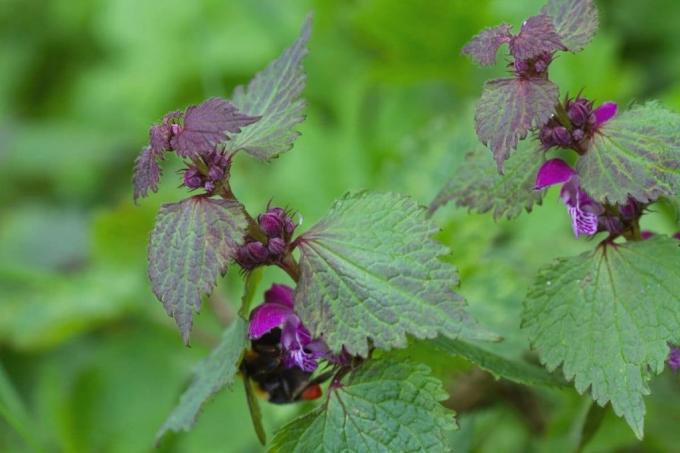
- Height: 15 to 20 cm
- Growth: upright, clumpy
- Flower: purple-pink, panicle-shaped
- Flowering period: May to July
- Leaves: ovate, serrated leaf margin, hairy, green
- Soil: fresh, well-drained, humus, rich in nutrients, slightly acidic
- Use: Underplanting in woody areas, woody edge
Tip: You can use the wild form of the spotted dead nettle as a perennial for the shade. Cultivated forms such as "Beacon Silver", which have an attractive green-white leaf color, are much more attractive.
Large star umbel (Astrantia major)

- Height: 40 to 50 cm
- Habit: bushy, clumpy, upright flower stalks
- Blossom: white-pink to greenish, umbel-shaped
- Flowering period: June to August
- Leaves: finger-shaped, serrated leaf margin, shiny, green
- Soil: fresh, moist, well-drained, humus, rich in nutrients
- Use: Underplanting in woody areas, woody edges, in the open air
Large-leaved lady's mantle (Alchemilla mollis)
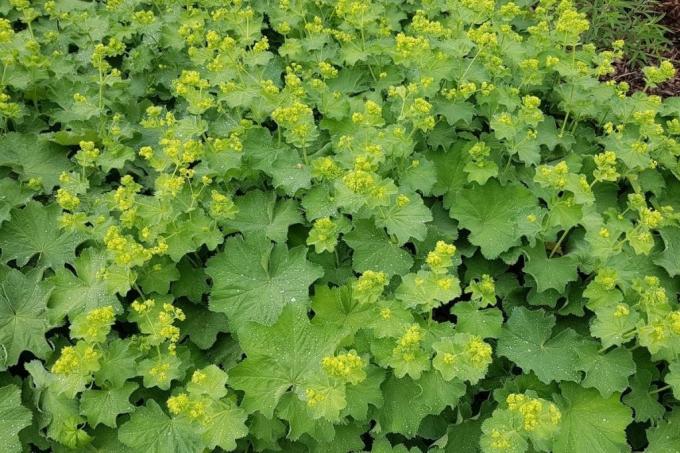
- Height: 30 to 40 cm
- Growth: pillow-like, clumpy
- Flower: green-yellow, umbel-shaped
- Flowering period: June to July
- Leaves: rounded, serrated or lobed leaf margin, hairy
- Soil: fresh, moist, well-drained, normal soil
- Use: ground cover, wooded edge
Large-leaved periwinkle (Vinca major)
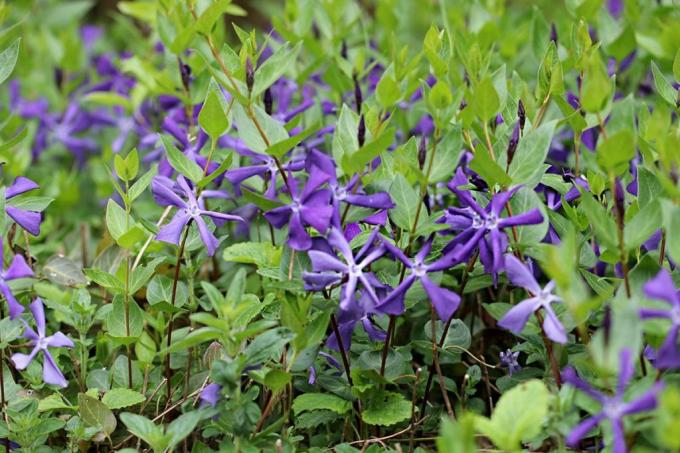
- Height: 20 to 30 cm
- Habit: upright, arching, forms runners
- Flower: violet-blue, cup-shaped
- Flowering period: April to May
- Leaves: ovate, pointed, dark green, evergreen
- Soil: moderately moist, humic, well-drained, sandy, loamy
- Use: Underplanting of trees, shrubs, ground cover
Shade perennials from H to S
Hazelwort (Asarum europaeum)
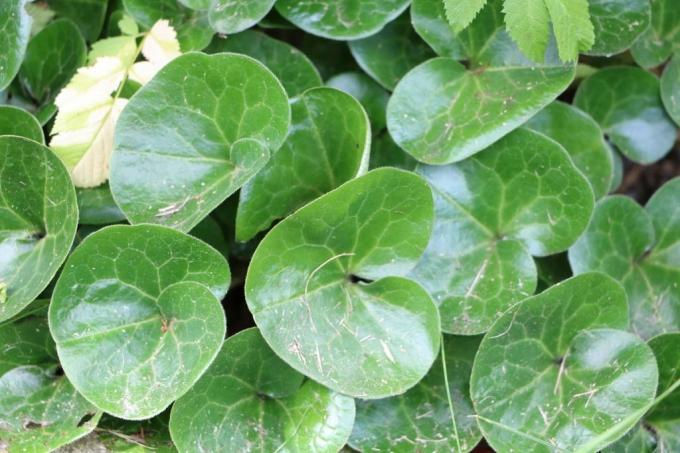
- Height: 3 to 15 cm
- Growth: creeping, flat
- Flower: red-brown, funnel-shaped
- Flowering period: March to April
- Leaves: kidney-shaped, shiny, evergreen
- Soil: humic, fresh, well-drained, calcareous soils preferred
- Use: Underplanting with woody plants, ground cover
Autumn anemone (Anemone japonica)
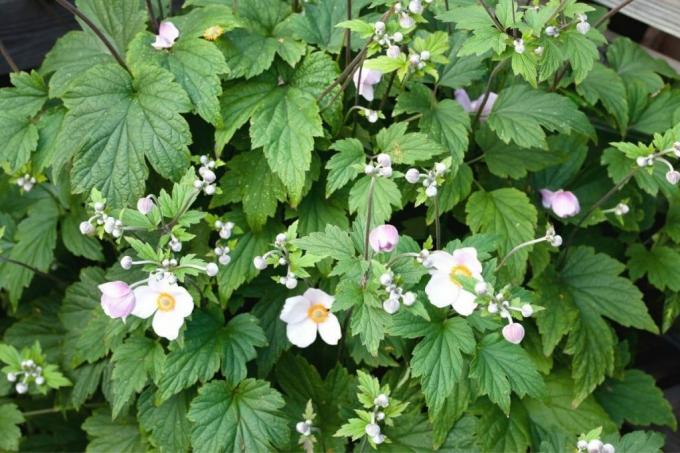
- Height: 70 to 90 cm
- Growth: spreading, clumpy, upright inflorescences
- Blossom: depending on the variety, pink or white, bowl-shaped
- Flowering period: September to October
- Leaves: heart-shaped, roughly serrate, hairy, deep green, deciduous
- Soil: very permeable, lots of humus
- Use: wooded edge, Bedding perennial
Heart-leaved foam blossom (Tiarella cordifolia)

- Height: 10 to 20 cm
- Growth: carpet-like, flat, forms runners
- Flower: yellow-white, panicle-shaped
- Flowering period: April to May
- Leaves: rounded, lobed, heart-shaped, hairy, lime green, evergreen
- Soil: humic, fresh, well-drained
- Use: edge of wood, bed perennial, ground cover, underplanting of wood
Caucasus forget-me-nots (Brunnera macrophylla)

- Height: 20 to 40 cm
- Growth: clumpy, bushy
- Flower: light blue, panicle-shaped,
- Flowering period: April to May
- Leaves: heart-shaped, rough, large, dark green, yellow autumn colors, deciduous
- Soil: fresh, moist, poor, humic, loamy
- Use: edge of wood, bed perennial, borders
Tip: The Caucasus forget-me-not is one of the few perennials that like it shady and also develop well on poor soil.
Creeping Gunsel (Ajuga reptans)
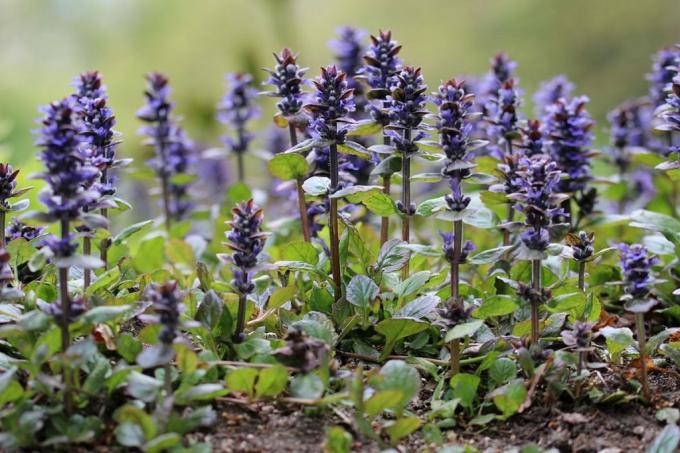
- Height: 10 to 15 cm
- Growth: carpet-like, forms runners
- Flower: blue-violet, spike-shaped
- Flowering period: May to June
- Leaves: tongue-shaped, glossy, evergreen
- Soil: humus, rich in nutrients, well drained
- Use: open spaces, ground cover, underplanting with woody plants
Note: The creeping Günsel is primarily suitable for areas that only get full shade after flowering, such as underplanting in woody plants.
Splendid spar (astilbe)

- Height: 30 to 50 cm
- Growth: pillow-like, expansive, bushy
- Blossom: depending on the variety, white, pink, light purple, panicle-shaped
- Flowering period: June to August
- Leaves: pinnate, lanceolate, serrated leaf margin, deciduous
- Soil: well-drained, fresh, moist, humic, rich in nutrients
- Use: perennial beds, container plants, borders, solitary shrubs
Black Christmas Rose (Helleborus niger)

- Height: 10 to 30 cm
- Growth: broadly bushy, clumpy
- Flower: simple, white
- Flowering period: January to April
- Leaves: palmate, leathery, dark green, evergreen
- Soil: fresh, humic, nutrient-rich, well-drained
- Use: Underplanting in woody areas, outdoors, shade beds
Note: The Christmas rose grows ideally Locationsthat let light through during their flowering period. It is suitable for underplanting deciduous trees or hedges.
September silver candle (Cimicifuga ramosa)

- Height: 50 to 180 cm
- Growth: arching, clumpy, expansive
- Flower: white, panicle-shaped
- Flowering period: September to October
- Leaves: roughly serrate, incised, red-violet, deciduous
- Soil: very well drained, humic, rich in nutrients
- Use: Underplanting in woody areas, woody edge
Shade perennials from T to W
Bleeding Heart (Lamprocapnosspectabilis)
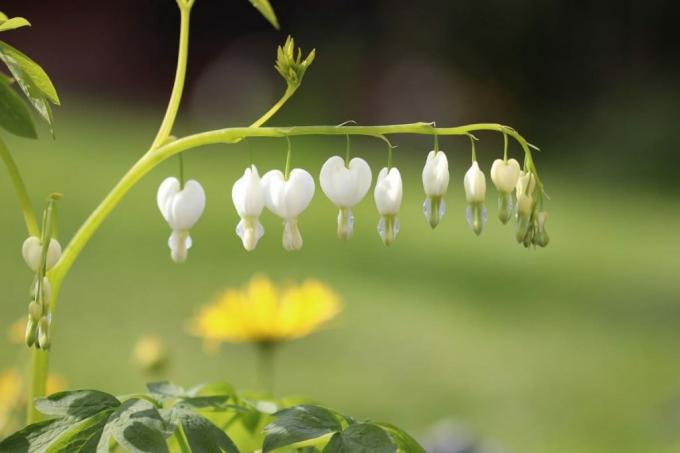
- Height: 60 to 80 cm
- Growth: spreading, upright, clumpy
- Blossom: depending on the variety, pure white or pink with white, grape-shaped
- Flowering period: May - June
- Leaves: three-lobed, soft, deciduous, blue-green
- Soil: fresh, well-drained, humus, rich in nutrients
- Use: edge of wood, shade beds, specimen plant
Many-flowered Solomon's seal (Polygonatum multiflorum)
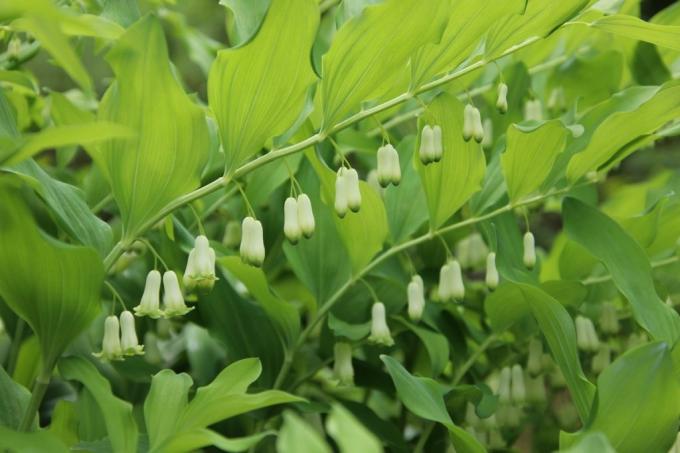
- Height: 50 to 60 cm
- Growth: upright, overhanging, forms rhizomes
- Blossom: white, racemose
- Flowering period: May to June
- Leaves: ovate, pointed, dull, green, deciduous
- Soil: fresh, well-drained normal soil
- Use: edge of wood, underplanting under tall wood
Forest goat's beard (Aruncus dioicus)
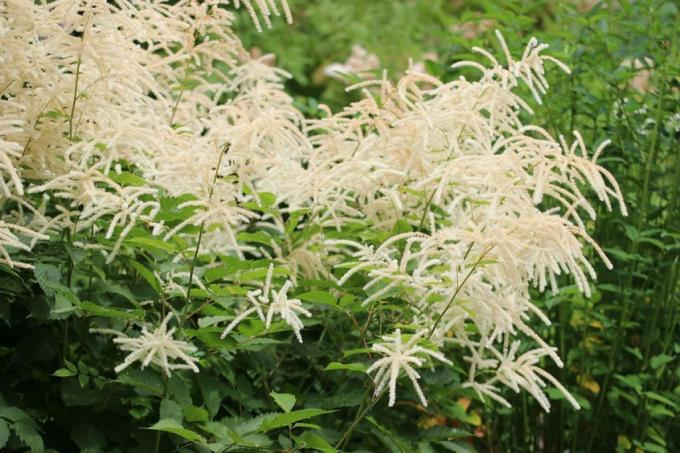
- Height: 150 to 180 cm
- Growth: upright, spreading, clumpy
- Blossom: white-yellowish, panicle-shaped
- Flowering period: June to July
- Leaves: pinnate, roughly serrated leaf margin, dull, smooth, deep green, deciduous
- Soil: well-drained, very humus, high nutrient requirement
- Use: edge of wood, underplanting under tall wood, specimen perennial
Woodruff (Galium odoratum)

- Height: 10 to 30 cm
- Habit: flat, upright, forms runners
- Blossom: white, umbel-shaped
- Flowering period: April to May
- Leaves: lanceolate, whorled, deciduous
- Soil: well drained, very humic
- Use: edge of wood, underplanting under tall wood
Tip: The woodruff is one of those perennials that not only grow well in extremely shady locations such as on the north side of houses, it is also edible. It can be used to prepare drinks such as punch bowls or teas.
Forest sedge (Carex sylvatica)
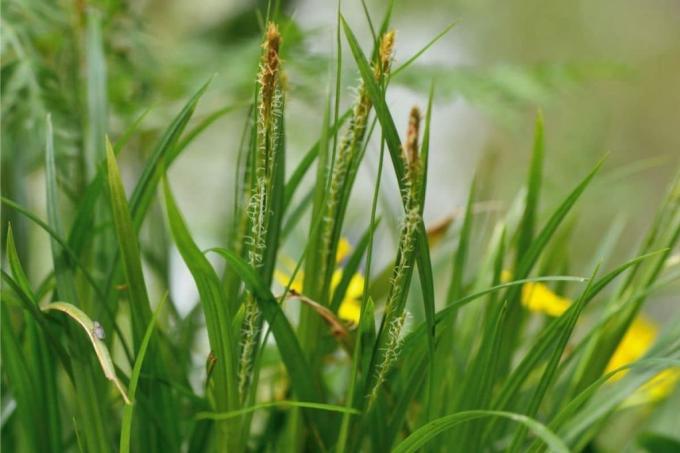
- Height: 30 to 70 cm
- Habit: curved leaves, upright inflorescences
- Flower: simple, brown, spike-shaped
- Flowering period: May to June
- Leaves: linear, pointed, smooth, shiny, light green
- Soil: fresh, moist, well-drained, rich in nutrients, humic, loamy, sandy
- Use: Underplanting with trees
Forest ledges (Luzula sylvatica)
- Height: 20 to 60 cm
- Habit: loose clumps, like a lawn
- Flower: brown, spike-shaped
- Flowering period: May to June
- Leaves: broad ruler, silvery, shiny, evergreen
- Soil: humic, fresh, well-drained
- Use: Underplanting of trees, shrubs, ground cover
White forest aster (Aster divaricatus)

- Height: 30 to 40 cm
- Habit: clumpy, upright inflorescences
- Blossom: white, umbel-shaped
- Flowering period: July to October
- Leaves: lanceolate, tapering to a point, dark green, deciduous
- Soil: fresh
- Use: Underplanting of trees, wood edges, group planting, open spaces
frequently asked Questions
That depends on the respective species. Species like the creeping günsel or the woodruff simply have to be cut off or mowed once a year. Plants like the periwinkle practically require no maintenance, you can even leave bloomed inflorescences as they move in after a short time.
Most perennials for shady locations have medium to high nutrient requirements. You should therefore regularly provide the plants with organic fertilizer. Alternatively, you can also mulch continuously, as the mulch brings new nutrients into the soil as it decomposes.
Perennials that prefer a shady location often have medium to high water requirements. You should pay particular attention to this when planting perennials in the tub, as the perennials there often get too little water.
